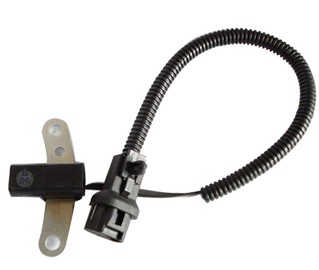Foreword
This article refers to the address: http://
The sensor has a wide range of applications in automotive electronic stability control systems (automobile electronic control systems), lane departure warning systems and blind spot detection systems, which contribute to the integration and intelligence of modern vehicles. So what are the car sensors? What are the sensors used in the car? What are the functions of the car? The car sensor is the input device of the car computer system. It stores various working conditions information such as the speed of the car. The temperature of the medium, engine operating conditions, etc., are converted into electrical signals and sent to the computer so that the engine is in optimal working condition. There are many car sensors, and their functions are not the same. The author will provide detailed answers to the above questions through collection and collation.

Automotive sensor
Introduction of automotive sensors for different purposes
Chassis control sensor
(1) The chassis control sensor refers to a sensor used in a chassis control system such as a transmission control system, a suspension control system, a power steering system, and an anti-lock brake system. These sensors, although distributed in different systems, work the same way as the corresponding sensors in the engine. Moreover, with the increased integration of automotive electronic control systems and the widespread use of CAN-BUS technology, the same sensor can not only provide signals to the engine control system, but also provide signals to the chassis control system.
(2) Sensors for automatic transmission systems
The sensors for the automatic transmission system mainly include a vehicle speed sensor, an accelerator pedal position sensor, an acceleration sensor, a throttle position sensor, an engine speed sensor, a water temperature sensor, and an oil temperature sensor. The sensors for the anti-lock braking system mainly include: a wheel speed sensor and a vehicle speed sensor;
(3) Sensors for suspension systems
Suspension system sensors mainly include: vehicle speed sensor, throttle position sensor, acceleration sensor, vehicle height sensor, steering wheel angle sensor, etc.; power steering system sensors mainly include: vehicle speed sensor, engine speed sensor, torque sensor, oil pressure sensor Wait.
(4) Sensor for body control
Sensors for body control are mainly used to improve the safety, reliability and comfort of automobiles. Since the working conditions are not as bad as those of the engine and the chassis, general industrial sensors can be applied with a slight improvement. There are mainly temperature sensors, humidity sensors, air volume sensors, sunshine sensors, etc. for automatic air conditioning systems; acceleration sensors for use in airbag systems; vehicle speed sensors for door lock control; and light sensors for automatic brightness control; An ultrasonic sensor or a laser sensor used in reversing control; a distance sensor for maintaining a vehicle distance; an image sensor for eliminating a blind spot of a driver, and the like.
(5) Sensors for navigation systems (vehicle GPS)
With the application of GPS/GIS (Global Positioning System and Geographic Information System) based navigation systems in automobiles, navigation sensors have grown rapidly in recent years. The sensors for the navigation system mainly include: a compass sensor that determines the direction of travel of the car, a gyroscope and a vehicle speed sensor, and a steering wheel angle sensor.
The development trend of automotive sensors
Due to the important role of automotive sensors in automotive electronic control systems and the rapidly growing market demand, countries around the world attach great importance to their theoretical research, new material applications and new product development. The future development trend of automotive sensor technology is miniaturization, multi-functionality, integration and intelligence.
Micro-sensors are based on MEMS (micro-electro-mechanical systems) developed from semiconductor integrated circuit technology. Micro-sensors use micro-machining technology to package micro-scale sensitive components, signal processors, and data processing devices on a fast chip. Small size, low price, easy integration, etc., can significantly improve the system test accuracy. The technology is now maturing and can produce a variety of miniature sensors that are sensitive and detect mechanical, magnetic, thermal, chemical and biomass. Due to the advantages of MEMS-based miniature sensors in reducing the cost and improving the performance of automotive electronic systems, they have begun to gradually replace sensors based on traditional electromechanical technology.
Multi-functionality means that one sensor can detect two or more characteristic parameters or chemical parameters, thereby reducing the number of automotive sensors and improving system reliability.
Integration refers to the fabrication of IC sensors using IC manufacturing techniques and fine processing techniques.
Intelligent means that the sensor is combined with a large-scale integrated circuit, with a CPU, with intelligent functions to reduce the complexity of the ECU, reduce its size, and reduce costs.
to sum up
With the development of electronic technology (automobile control technology) and the increasing application of automotive electronic control systems, automotive sensors have become one of the core contents of research in the field of automotive electronics technology. This paper briefly introduces the concept, classification and future development of automotive sensors, and introduces the sensors of several main applications in automobiles.
Fiber Optical Splice Closure(FOSC) is provided to provide a solid protection for fiber optic splice points, YULIANG Telecom offers a full range, various models of FOSC with both Inland type and DOME types, YULIANG Telcom FOSC are applied for underground, aerial, pipeline, manhole with protection level reaches IP68.

Fiber Optic Splice Closure,Fiber Splice Enclosure,Optical Fiber Splice Closure,Fiber Optical Splice Closure
NINGBO YULIANG TELECOM MUNICATIONS EQUIPMENT CO.,LTD. , https://www.yltelecom.com